Vadstena has preserved a lot of its medieval surroundings. The oldest building, Folkungaättens palace, was built in the 1260’s and became a part of the Birgitta systers’ first monastery in the 1300's. In Vastena’s oldest square (Rådhustorget) you can find the town hall that was built shortly after Vadstena received its city charter in 1400. In the square you can also find houses from every century between the 15th and 21st century. Between the old monastery and the castle there a several old, preserved buildings. Even around the hospital area, behind the monastery wall, there are many more old buildings remaining.
“Cultural and historical buildings in Vadstena” help you discover the town on foot. You can also participate in a guided tour, that tells the story of the towns history and you even have the chance to meet an historical person. The quickest way to the see the city is to take the guided KungsTåget, that leaves from Arkivgatan (eastern moat) during the summer months.
If you would like to know more about the development of the city and its residents, you are welcome to visit the Town Museum in Rådhustorget [5]. The museum is open during the summer every day between 13:00 and 16:00, free admission. Deviations may occur.
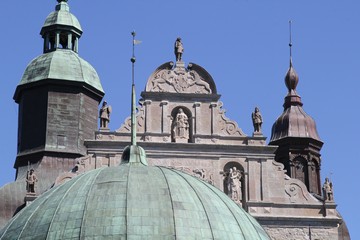
1. Vadstena Castle (Vadstena slott)
Lying on lake Vättern is Vadstena Castle. Construction started in 1545 by Gustav Vasa with the purpose of
strengthening Sweden during troubling times. The initial plans were for a modern defence establishment,
but the King’s son Johan III changed the plans and it became a grand renaissance castle. The castle was
finished in 1620 and has three floors of the original layout remaining. It is the best-preserved renaissance
castle in Scandinavia.
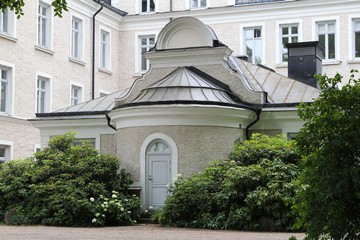
2. The Asylen park (Asylenparken)
It was originally built by Gusav Vasa as the gardens to the Castle. During the 19th century the main buildings
were used for a sugar factory, a tobacco factory and a mental hospital. Since 1986 it has been used as private
accommodation, hotel accommodation and the Vadstena’s library.
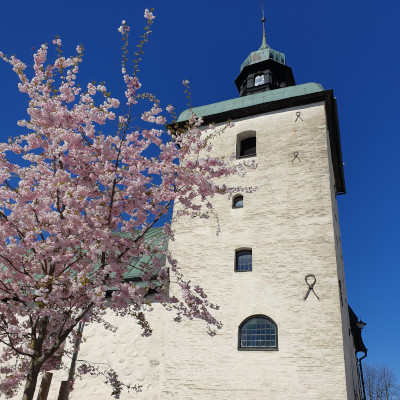
3. The Town Hall (Rådhuset)
Vadstenas town hall is the oldest preserved town hall in Sweden and was built in the middle of the 15th century.
The town house was used for council meetings until late 1970s and today is a listed building.
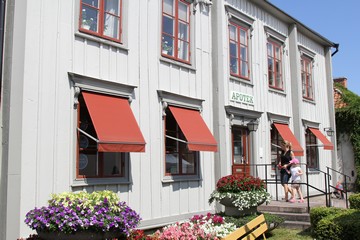
4. Pharmacy (Apotekshuset)
Vadstena’s pharmacy was erected in 1705 by Anders Eriksson and since 1830 has been home to Vadstena’s pharmacy.
The building is listed and has a preserved interior.
5. Vadstena’s town museum (Vadstena stadsmuseum)
The western part, towards the pharmacy, was mentioned in the 1550s. Enlarged in the beginning of the 19th
century, it has been used for storage for the pharmacy and the office for Dals savings bank. Since 1949 it has been
home to the Vadstena Town Museum.
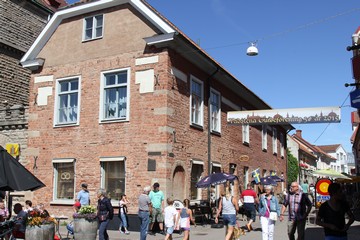
6. Udd Jönsson’s house (Udd Jönssons hus)
This attractive location on the corner of the square has, since the 15th century, been mostly used for retail.
Initially wooden buildings stood here, they were replaced by stone buildings in 1559 by the wealthy merchant and
major Udd Jönsson and his sons.
7. Lars Guldsmed’s plot (Lars Guldsmeds tomt)
The stone house was probably built in the middle of the 15th century and is a good example of the stone houses
that merchants often built on their own plots for safer storage of their goods.
8. Sven Västgöte’s courtyard
The oldest part of the house was built at the end of the 15th century and the oldest known owner of courtyard was
Sven Jönsson Västgöte, the sheriff of Vadstena Castle. It has since housed both a bank office and a butcher.
9. Tomas Göransson’s House (Tomas Göranssons gård)
The white stone house inside the grounds is a medieval house that was probably used as a storeroom.
The site was owned by the burgher Tomas Göransson during the end of the 16th century.
10. Helgeandsgården
Helgeandshuset in Vadstena is first mentioned in a papal bull in 1399, when it was governed by the monastery.
During medieval times, it was an institution for the sick, elderly and poor. After a devastating fire, the current
building was built in 1487. It has since been home to several governors. Since 1903 the old bakery
(Gamla Konditoriet) has been operating on the premises.
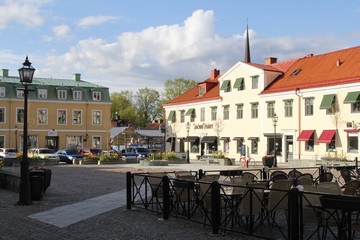
11. "Långholmen"
In the 1660s, the site was occupied by three plots owned by the wealthy goldsmith and mayor Bertil Henriksson.
In the mid-1800s the current buildings were built, and since 1918 has housed business premises on the entire ground floor.
11. "Långholmen"
In the 1660s, the site was occupied by three plots owned by the wealthy goldsmith and mayor Bertil Henriksson.
In the mid-1800s the current buildings were built, and since 1918 has housed business premises on the entire ground floor.
12. Johan Apotekares plot (Johan Apotekares gård)
During the 17th century, it was owned by Duke Johan of Östergötland's pharmacist, alderman Johan Apotekare.
In 1898 the building got its current form, and is one of only two buildings in Vadstena centre that has three entire floors.
13. Jöns Krämares buildings (Jöns Krämares gård)
Merchant and mayor Jöns Hansson Krämare built a trading house on the site in 1577. The outbuildings on Fyllagatan are
typical for smaller commercial sites with doorways. The have since contained stables, storerooms, and so on.
Today, these are private homes.
14. Mårten Ulfssons house - Hotell Finspong (Mårten Ulfssons hus - Hotell Finspong)
After the Danes' pillaging of Vadstena in 1567, Marten Ulfsson wanted to leave the city but did not get the
permission of John III to do so. But the king offered a tax exemption if he built a stone or timber-framed house -
a two-floored house with an attic was built. In 1840 the building was converted into an inn and tavern, called
Hotel Finspong. Today the hotel's old hall is used by Vadstena’s New Theatre.
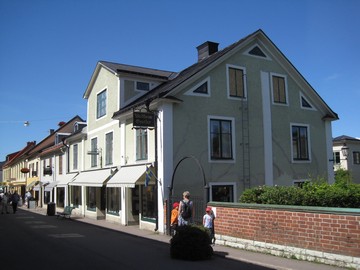
15. Elsa Petersons plot (Elsa Petersons gård)
On the plot lies one of the best-preserved houses from the 15th century in Vadstena.
Elsa Petersson’s lace shop moved into the premises in 1920. The lace shop has recently closed down and operates online.
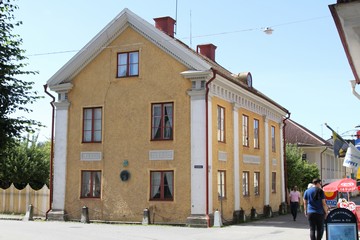
16. Acharii-Bergenstråhlska house (Acharii-Bergenstråhlska garden)
A house that has been home to many well-known people, for example sculptor and painter Johan Werner,
scientist Eric Acharius, captain Carl Ulric Bergenstråhle and mayor Theodore Lagercrantz. At the Abbey’s
consecration in 1898, the city’s chairman invited celebrity guests to lunch at the premises, such as King
Oscar II and Crown Prince Gustaf (V).
17. Falkenbergska gården
The ground floor was built around 1700, but the house got its current appearance in 1843.
The house is typical of a late 19th century house.
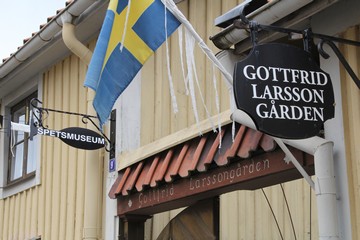
18. Gottfrid Larsson’s house (Gottfrid Larssongården)
The site’s main building stem from the old part from the 1670’s. The sculpture Gottfrid Larsson’s wife Karen
Larsson-Waaler bought the site in 1949, after her husband’s death, and converted it into a museum of her husband’s
sculpture collection. The Gottfrid Larsson museum is open for visiting and you can see about 125 sculptures,
and even visit Vadstena’s Lace Museum that moved in in 2005.
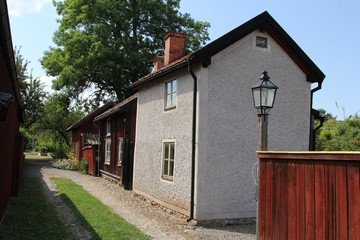
19. The Shoe Maker's Cottages (Skomakarstugorna)
Both cottages were originally located on Backegatan’s south side, and in the 1820’s was there a pub in one of them.
In 1910 the shoemaker Karl Pontus Pettersson bought the cottages. In 1957 the buildings moved to their current location.
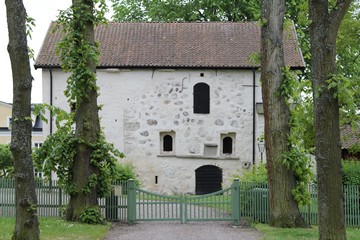
20. The Bishop’s House (Biskopshuset)
Linköping’s bishop, Henrik Tidemansson, build the house in 1473. It had just one room with brick floors and
limestone walls, covered with religious text in old Swedish. The house was renovated in 1528 to be the residence
for Gustav Vasa and it is said that he lived here during the construction of Vadstena’s castle.
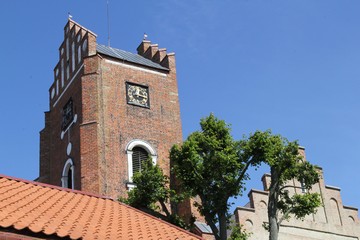
21. The Red Tower (Rödtornet)
A romantic era church in limestone, was situated on the north end of the red tower in the 12th century but
the church was destroyed during the town’s fire in 1423. In 1460 the church St.Per was built, but due to
severe subsidence the chapel was destroyed in 1829. The church tower and some parts of the original church
remains and is used for the bells for the monastery.
City walk on your own
Would you like to do a city walk on your own? Here is a suggestion. The walk from Asylen (Asylum) to Bishop's House
is 2 km long and takes 1 hour 30 minutes. You can navigate online and offline with our map (pdf).
Read more under City walk.
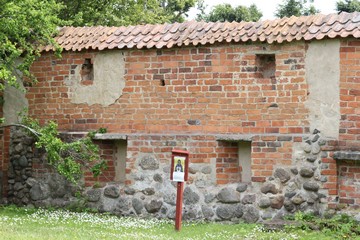
22. The Monastery Walls and Beginerna’s house (Klostermuren med Beginernas hus)
In 1506 the monks began to extend their garden southwards and built a new brick wall to enclose the new gardens.
Beginerna was a voluntary convent who were supported by the nuns in the convent, but strongly opposed by the monks.
In 1506 they were driven away by the monks during the sisters' protests.
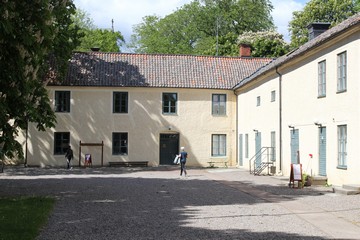
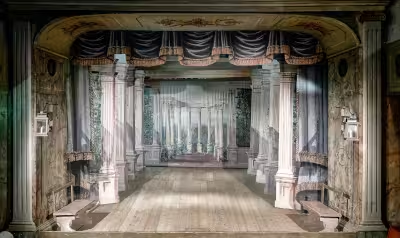
23. The Monk’s Garden and The Old Theatre (Munkträdgården och Gamla teatern)
The monk’s garden was one of the monastery’s two orchards during the beginning of the 16th century. It is
one of Sweden’s oldest with various sorts of apple and pear trees. In 1847, the current theatre was built
which is Sweden’s oldest preserved privately-built provincial theatres, which is still used today for
various theatre and opera productions.
In 2025, the Old Theatre will be 200 years old. Under the theme Vadstena Gamla teater - 200 år av liv och lust! (The Old Vadstena Theatre - 200 years of life and lust!) the Vadstena Academy is honouring the anniversary.
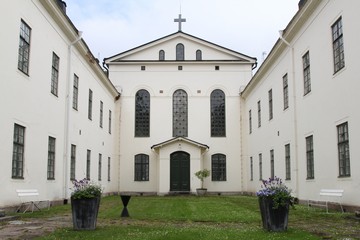
24. The Old Hospital & Trinity Church (Trefaldighetskyrkan)
In 1520 Mårten Skinnare founded a hospital in Vadstena, which was originally built on this site. In 1704 the
hospital moved to its current location, and in 1860 a new building was constructed consisting of two longer
buildings with a church in the middle. Today it houses Vadstena high school and Vadstena Academy (Vadstena-Akademien).
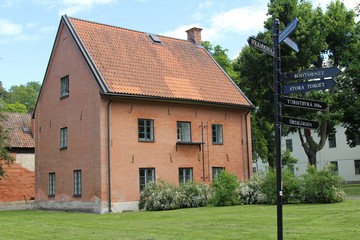
25. The Hospital Museum (Hospitalmuseet) – The Large Madhouse (Stora dårhuset)
”The large madhouse” was the first hospital in Sweden for the mentally ill. It was finished in 1757.
Since 1977 it has been the hospital museum (Hospitalsmuseet).
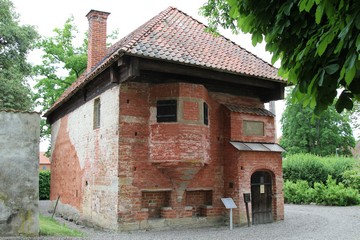
26. Mårten Skinnares house (Mårten Skinnares hus)
The rich merchant Mårten Nilsson traded in fur and skins - hence his nickname “the skinner” (Skinnare).
He received three plots of land on the banks of the monastery to build a hospital, a smaller hospital for the
poor and pilgrims. Today the site shows a rare late medieval preserved residential building that you can visit
inside via guided tours.
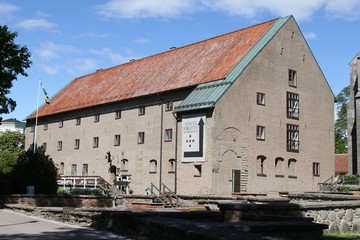
27. Soldier’s House – the west wing (Krigsmanshuset - västra längan)
Vadstena’s double monastery was inaugurated in 1384, and the west wing included a summer and a winter dining room
on the ground floor. In 1595 the monastery closed and in the 1640’s it was converted into a lodging for injured
soldiers and their families. Today, it is a part of the Vadstena Kloster Hotell.
28. The Monk’s Monastery (Munkklostret)
The monk’s monastery was used as a monastery between 1384 and 1530. Among other uses, the building was later
used as a “cure house” for venereal diseases and a hospital. Since the 1980’s it has housed Restaurant Munkklostret.
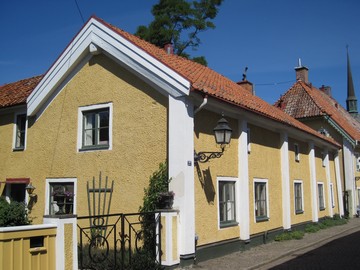
29. Odhnerska – The Dyer’s Yard (Odhnerska gården – Färgargården)
In 1750, the building housed the industrialist August Wessman’s dye-works. At the end of the 18th century a
second floor was added and under the current brick floor are the remains of the old turf roof. The large,
grey stone shed was used as a beer cellar during the late Middle Ages.
Sightseeing tours by train
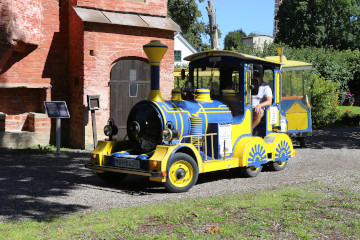
The blue and yellow train takes you on a guided tour of medieval Vadstena. Join one of the tours that start at
the castle moat in high season, or book your own tour for your wedding celebration, party, conference, family
party or school class.
Read more under KungsTåget.
30. Sjunnessonska trade yard (Sjunnessonska handelsgården)
The main building was erected by the mayor Eric Gezelius in 1800, built as per typical Vadstena layout of the time:
a large room surrounded by the two chambers on either side. Between 1872 and 1975 there was a reputable grocery
store on the yard known as Carlings.
31. Casellska factory (Casellska gården – fabriksgården)
In 1813 the current housing was constructed, and between 1890 and 1915 the building housed a cigar factory.
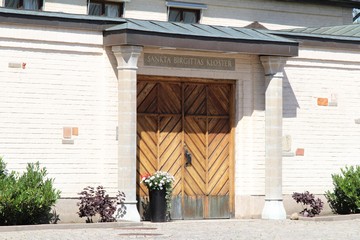
32. Saint Birgitta’s Abbey and Church (Sankta Birgittas kloster och kyrka)
The current kloster buildings were built 1972. Klosterklausuren, which is not open to the public, is designed
for 20 nuns and includes a traditional grassyard, surrounded by a high brick wall.
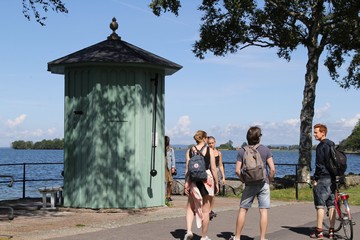
33. The Town’s Pier (Stadsbryggan)
Because of the shallow beach lake, long piers & jetties were built to facilitate the arrival of lake traffic,
and the city’s jetty at the end of Helgeandsgatan was built in 1529. Next to the jetty there were low boathouses,
and in the mid-1800s this was the location of the city’s pump.
34. Jöns Wettermans house (Jöns Wettermans gård)
The house was bought in 1700 by mayor Jöns Wetterman. As one of the richest mayors of Vadstena, he built a stately
house that he was forced to sell in 1714 to cover his debts to the queen mother Hedvig Eleonora.
35. Mayor Janssons house (Rådman Janssons gård)
Alderman Johan Jansson was Vadstena’s leading trader and farmer during the middle of the 18th century.
He owned many of the most important houses and land in Vadstena. He began to build this large stone
house if 1764 and lived nearby.
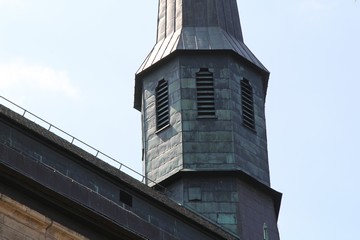
36. The Abbey (Klosterkyrkan)
Vadstena’s Abbey is one of the largest medieval church buildings in Sweden. Even today, many pilgrims travel
to The Abbey with Saint Birgitta's shrine. The Abbey has three stars in the Michelin guide and nearly 300,000 visitors every year.
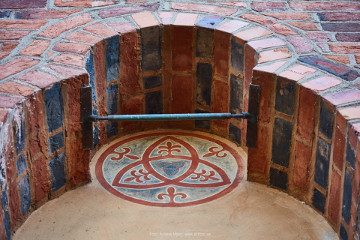 The King’s Palace (Kungapalatset) - Photo: Anders Malm, www.sldfoto.se
The King’s Palace (Kungapalatset) - Photo: Anders Malm, www.sldfoto.se
37. The King’s Palace (Kungapalatset)
The palace was built by King Valdmar during the 1260’s. It was used as a summer residence for the king until 1346,
when it was bequeathed by King Magnus Eriksson and Queen Blanka. Today you will find the St. Birgitta Convent Museum on the premises
 Udd Jönsson's house
Udd Jönsson's house
 Bishop's house from 1473
Bishop's house from 1473
Town Hall Square - Storgatan - Helgeandsgården - Abbey Pax Mariae - Lake front promenade - Vadstena Monastery and Abbey Church - Red Tower - Bishop's House
Between Wasa Castle and the Monastery Quarter, Vadstena's old town stretches out with its narrow streets and alleys, giving it a medieval feel. There are more than thirty heritage buildings, the oldest of which date back to the founding of the town and the monastery from the 15th century onwards. Of interest is the Town Hall Square with Sweden's oldest preserved town hall from 1460 and various buildings from all centuries. This city walk combines a relaxing stroll with a journey of discovery through the city and its history.
Language: Swedish, German, English
Time: 1 - 1 1/2 hours
Participants: max. 25 people / group and guide
Price:
Monday-Friday: 1875 SEK incl. VAT
Saturday/Sunday/Holiday: 2250 SEK incl. VAT
Mini groups:
Monday-Friday: 150 SEK per person, minimum 900 SEK incl. VAT.
Saturday/Sunday/Holiday: 180 SEK per person, minimum 1080 SEK incl. VAT.
The above description follows the "traditional" route. However, we are happy to adapt the tour to specific requests and themes.
UpplevVadstena AB
Skedagatan 208, 592 93 Borghamn
+46-143-201 19, +46-76-765 1317

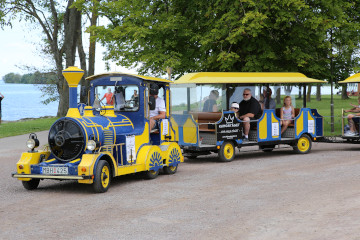
25 minuters guidad tur ombord på KungsTåget genom Vadstena och till stadens sevärdheter från klostret och hospitalet till hamnen och slottet.
The blue and yellow train takes you on a guided tour of medieval Vadstena. Join one of the tours that start at the castle moat in high season, or book your own tour for your wedding celebration, party, conference, family party or school class.
The tour is in Swedish. However, you can also choose to receive information in German or English via headphones.
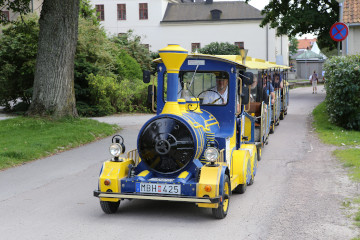
Dates and times 2025
4 June - 19 August: Tours wednesday-sunday.
Tours depart at 11:00, 11:45, 12:30, 13:15 and 14:00.
21 June - 31 August: Daily tours.
Tours depart at 11:00, 11:45, 12:30, 13:15, 14:00, 14:45 and 15:30.
Subject for change due to pre-booked tours.
In good weather also tours in the early and late season. See Kungståget or ask +46-70-3390 250.
Departure point
Departure and arrival at eastern moat (Arkivgatan).
Tickets
Tickets can be purchased before boarding the train. 90 SEK adults, 70 SEK children under 12 years, children 0-4 years free.
Dogs 40 SEK, only sitting on the floor and on a leash.
Come early if you want to join a particular ride, as the train fills up quickly. No seat reservation and first come, first served.
Organiser
Hedenskog Nöjen
+46-70-3390 250